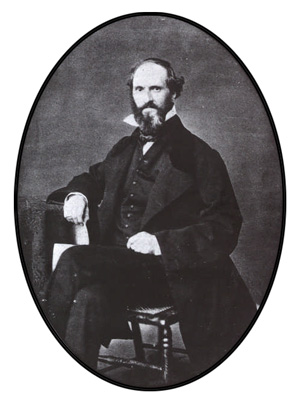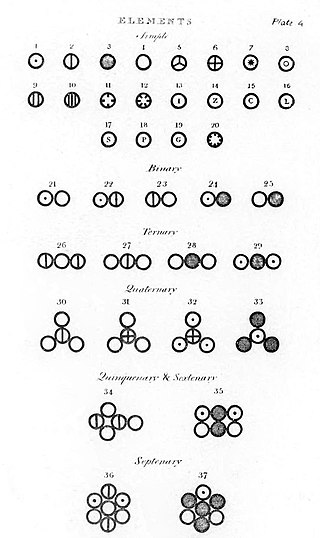Related Research Articles

Dmitri Ivanovich Mendeleev was a Russian chemist and inventor. He is best known for formulating the Periodic Law and creating a version of the periodic table of elements. He used the Periodic Law not only to correct the then-accepted properties of some known elements, such as the valence and atomic weight of uranium, but also to predict the properties of three elements that were yet to be discovered.

H. L. Hunley, also known as the Hunley, CSS H. L. Hunley, or CSS Hunley, was a submarine of the Confederate States of America that played a small part in the American Civil War. Hunley demonstrated the advantages and dangers of undersea warfare. She was the first combat submarine to sink a warship (USS Housatonic), although Hunley was not completely submerged and, following her attack, was lost along with her crew before she could return to base. Twenty-one crewmen died in the three sinkings of Hunley during her short career. She was named for her inventor, Horace Lawson Hunley, shortly after she was taken into government service under the control of the Confederate States Army at Charleston, South Carolina.

John Alexander Reina Newlands was a British chemist who worked concerning the periodicity of elements.
In chemistry, the law of mass action is the proposition that the rate of a chemical reaction is directly proportional to the product of the activities or concentrations of the reactants. It explains and predicts behaviors of solutions in dynamic equilibrium. Specifically, it implies that for a chemical reaction mixture that is in equilibrium, the ratio between the concentration of reactants and products is constant.
The year 1944 in science and technology involved some significant events, listed below.
Chemical kinetics, also known as reaction kinetics, is the branch of physical chemistry that is concerned with understanding the rates of chemical reactions. It is different from chemical thermodynamics, which deals with the direction in which a reaction occurs but in itself tells nothing about its rate. Chemical kinetics includes investigations of how experimental conditions influence the speed of a chemical reaction and yield information about the reaction's mechanism and transition states, as well as the construction of mathematical models that also can describe the characteristics of a chemical reaction.
The year 1817 in science and technology involved some significant events, listed below.
The year 1875 in science and technology involved some significant events, listed below.
The year 1869 in science and technology involved some significant events, listed below.

The periodic table is an arrangement of the chemical elements, structured by their atomic number, electron configuration and recurring chemical properties. In the basic form, elements are presented in order of increasing atomic number, in the reading sequence. Then, rows and columns are created by starting new rows and inserting blank cells, so that rows (periods) and columns (groups) show elements with recurring properties. For example, all elements in group (column) 18 are noble gases that are largely—though not completely—unreactive.

Julius Lothar Meyer was a German chemist. He was one of the pioneers in developing the earliest versions of the periodic table of the chemical elements. The Russian chemist Dmitri Mendeleev and he had both worked with Robert Bunsen. Meyer never used his first given name and was known throughout his life simply as Lothar Meyer.

Richard Spruce was an English botanist specializing in bryology. One of the great Victorian botanical explorers, Spruce spent 15 years exploring the Amazon from the Andes to its mouth, and was one of the first Europeans to visit many of the places where he collected specimens. Spruce discovered and named a number of new plant species, and corresponded with some of the leading botanists of the nineteenth century.

Jakob Johann Freiherr von Uexküll was a Baltic German biologist who worked in the fields of muscular physiology and animal behaviour studies and was an influence on the cybernetics of life. However, his most notable contribution is the notion of Umwelt, used by semiotician Thomas Sebeok and philosopher Martin Heidegger. His works established biosemiotics as a field of research.

Peter Waage was a Norwegian chemist and professor of chemistry at the University of Kristiania. Along with his brother-in-law Cato Maximilian Guldberg, he co-discovered and developed the law of mass action between 1864 and 1879.

Clemens Alexander Winkler was a German chemist who discovered the element germanium in 1886, solidifying Dmitri Mendeleev's theory of periodicity.

Odd Hassel was a Norwegian physical chemist and Nobel Laureate.

Cato Maximilian Guldberg was a Norwegian mathematician and chemist. Guldberg is best known as a pioneer in physical chemistry.
Events from the year 1864 in the United Kingdom.

This timeline of chemistry lists important works, discoveries, ideas, inventions, and experiments that significantly changed humanity's understanding of the modern science known as chemistry, defined as the scientific study of the composition of matter and of its interactions.
References
- ↑ Kwok, Sun (2000). "History and overview". The Origin and Evolution of planetary Nebulae. Cambridge University Press. pp. 1–7. ISBN 0-521-62313-8 . Retrieved 13 January 2012.[ permanent dead link ]
- ↑ Spruce, Richard (1884). "Hepaticae of the Amazon and the Andes of Peru and Ecuador". Transactions and Proceedings of the Botanical Society. 15 (1–2). Edinburgh.
- ↑ Spruce, Richard (1908). Wallace, Alfred Russel (ed.). Notes of a botanist on the Amazon and the Andes... during the years 1849–1864. London: Macmillan.
- ↑ Pearson, Michael (2004). Richard Spruce: naturalist and explorer. Settle, Yorkshire: Hudson History. ISBN 1-903783-28-3.
- ↑ Newlands, John A. R. (1864-08-20). "On Relations Among the Equivalents". Chemical News. 10: 94–95. Archived from the original on 21 July 2011. Retrieved 2011-08-30.
- ↑ "Julius Lothar Meyer and Dmitri Ivanovich Mendeleev". Science History Institute. Archived from the original on 21 March 2018. Retrieved 21 March 2018.
- ↑ Bowden, Mary Ellen (1997). "Julius Lothar Meyer and Dmitri Ivanovich Mendeleev". Chemical achievers : the human face of the chemical sciences . Philadelphia, PA: Chemical Heritage Foundation. pp. 59-63. ISBN 9780941901123.
- ↑ Guldberg, C. M.; Waage, P. (1864). "Studies Concerning Affinity". Forhandlinger i Videnskabs-Selskabet i Christiana: 35.
- ↑ Waage, P. (1864). "Experiments for Determining the Affinity Law". Forhandlinger i Videnskabs-Selskabet i Christiania: 92.
- ↑ Guldberg, C. M. (1864). "Concerning the Laws of Chemical Affinity". Forhandlinger i Videnskabs-Selskabet i Christiania: 111.
- ↑ Schaffer, Jeffrey P. Yosemite National Park (4th ed.). p. 48.
- ↑ Enneper, A. (1864). "Analytisch-geometrische Untersuchungen". Zeitschrift für mathematische Physik. 9: 96–125.
- ↑ Maxwell, J. Clerk (1865). "A dynamical theory of the electromagnetic field" (PDF). Philosophical Transactions of the Royal Society of London. 155: 459–512. doi:10.1098/rstl.1865.0008. Archived (PDF) from the original on 2011-07-28. Retrieved 2011-08-30.
- ↑ Chaffin, Tom (2008). The H. L. Hunley: the Secret Hope of the Confederacy . New York: Hill and Wang. ISBN 978-0-8090-9512-4.
- ↑ Penguin Pocket On This Day. Penguin Reference Library. 2006. ISBN 0-14-102715-0.
- ↑ "History". Oriel Chambers. Archived from the original on 2011-02-08. Retrieved 2009-07-27.
- ↑ "Henry Roscoe (1833-1915): flashlight photography". Museum of Science and Industry (Manchester). 2007. Archived from the original on 2012-03-02. Retrieved 2011-11-17.
- ↑ "Copley Medal | British scientific award". Encyclopedia Britannica. Archived from the original on 24 July 2020. Retrieved 23 July 2020.
- ↑ Brentari, Carlo (2015). Jakob von Uexküll: The Discovery of the Umwelt between Biosemiotics and Theoretical Biology. Springer.